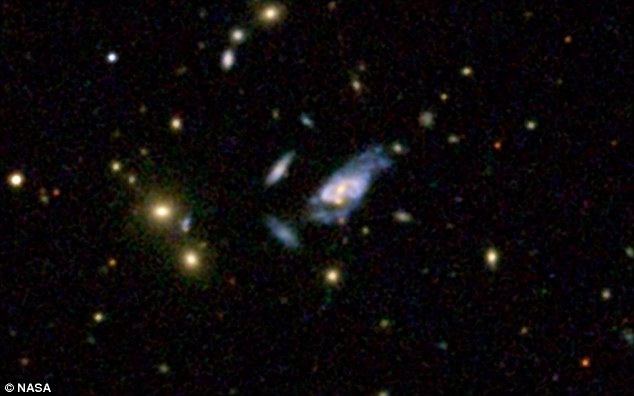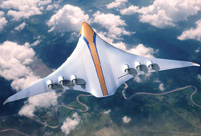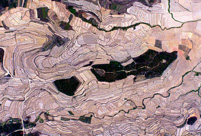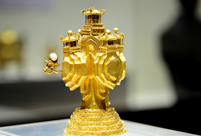

The researchers checked the distances to the spiral galaxies and saw that none were nearby - even the closest lay some 1.2 billion light-years away.
With the correct distance estimates in hand, the stunning properties of this newfound batch of whirlpool-shaped galaxies came to light.
Super spirals can shine with anywhere from eight to 14 times the brightness of the Milky Way.

Super spirals have long hidden in plain sight by mimicking the appearance of typical spiral galaxies. This super spiral on the left , catalogued as 2MASX J08542169+0449308, contains two galactic nuclei, instead of just the usual one. These double nuclei could offer a vital hint about the potential origin of super spirals
They possess as much as 10 times our galaxy's mass.
Their gleaming, starry disks stretch from twice to even four times the width of the Milky Way galaxy's approximately 100,000 light-year-wide disk, with the largest super spiral spanning a 440,000 light-years.
Super spirals also give off copious ultraviolet and mid-infrared light, signifying a breakneck pace of churning out new stars.
Their star formation rate is as high as 30 times that of our own run-of-the-mill galaxy.
According to established astrophysical theory, spiral galaxies should not be able to attain any of these feats because their size and star-making potential are limited.
As spiral galaxies grow by gravitationally attracting fresh, cool gas from intergalactic space, their masses reach a tipping point in which any newly captured gas rushes in too rapidly.
This headlong gas heats up and prevents subsequent star formation in a process known as 'quenching.'

Super spirals can shine with anywhere from eight to 14 times the brightness of the Milky Way. Pictured is a super spiral designated 2MASX J16014061+2718161, and it also contains the double nuclei
Bucking this wisdom, though, super spirals remain unquenched.
A vital hint about the potential origin of super spirals is that four out of the 53 seen by Ogle and colleagues clearly contain two galactic nuclei, instead of just one as usual.
Double nuclei, which look like two egg yolks frying in a pan, are a telltale sign of two galaxies having just merged together.
Conventionally, mergers of spiral galaxies are destined to become bloated, elliptical galaxies.
Yet Ogle and colleagues speculate that a special merger involving two, gas-rich spiral galaxies could see their pooled gases settle down into a new, larger stellar disk creating s super spiral.
'Super spirals could fundamentally change our understanding of the formation and evolution of the most massive galaxies,' said Ogle.
'We have much to learn from these newly identified, galactic leviathans.'
 |
 Thai most beautiful transgender Nong Poy release new photos
Thai most beautiful transgender Nong Poy release new photos Now and then photos of Shanghai Jiaotong University
Now and then photos of Shanghai Jiaotong University Is this what air travel will look like in 2050?
Is this what air travel will look like in 2050? Aerial view of watermelon terraces in S China's Baise
Aerial view of watermelon terraces in S China's Baise Traditional wedding of a post-80s Tibetan couple
Traditional wedding of a post-80s Tibetan couple Models in cheongsams present classical oriental beauty
Models in cheongsams present classical oriental beauty Second commissioned C28A corvette made by China enters Algerian Navy
Second commissioned C28A corvette made by China enters Algerian Navy Intoxicating Wuyuan in spring
Intoxicating Wuyuan in spring Gold and silver wares of Qing Dynasty exhibited in Shenyang Imperial Palace
Gold and silver wares of Qing Dynasty exhibited in Shenyang Imperial Palace Top 20 hottest women in the world in 2014
Top 20 hottest women in the world in 2014 Top 10 hardest languages to learn
Top 10 hardest languages to learn 10 Chinese female stars with most beautiful faces
10 Chinese female stars with most beautiful faces China’s Top 10 Unique Bridges, Highways and Roads
China’s Top 10 Unique Bridges, Highways and Roads Challenges seen in attracting foreign capital
Challenges seen in attracting foreign capital  Suspected matricide case highlights mental health problems in China’s elite colleges
Suspected matricide case highlights mental health problems in China’s elite colleges  Peering into North Korea from China’s border
Peering into North Korea from China’s border  Cross-Straits ‘diplomatic truce’ still holds
Cross-Straits ‘diplomatic truce’ still holds Day|Week